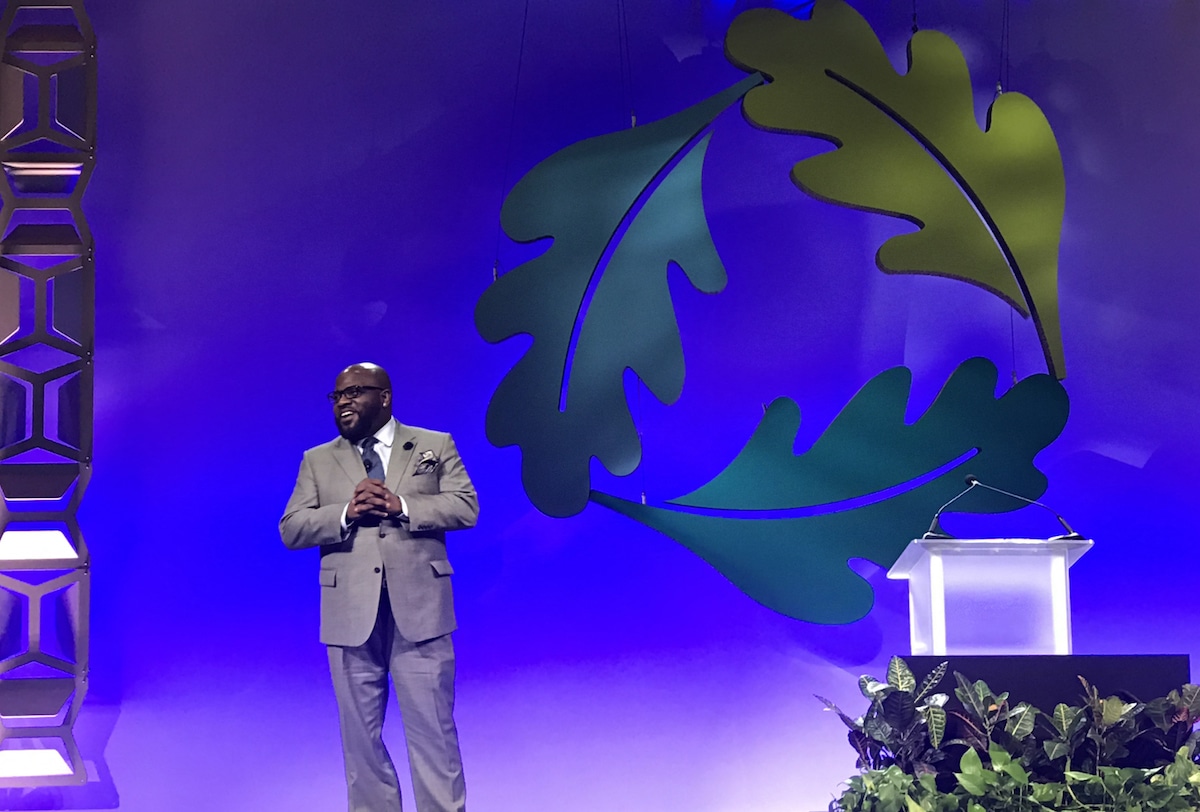
[Photo: Courtesy of Mohawk Group]
“I’m standing for a lot of folks … It’s like the aura of what people have given to you you can never give back, but it can become more of a seed for someone else. I like to plant those seeds at the same time.”
Vice President for Sustainability, Mohawk Group
Be humble. “Having humility with dignity with everyone you work with and with people you work for gives you the opportunity to be able to share and really explore a better understanding of people.”
I learned the value of working from 15 years old. “My first job was at the parks and recreation center, so when you talk about being humbled—picking up litter with a stick with a nail on the end, cleaning up bathrooms, laying a sidewalk from one end of the recreation center to the other—that was probably the hardest job I ever had … When I first started getting a check, my parents made me pay a bill. Whether it was the cable bill or help out with the light bill, I began to learn the value of understanding my connectivity to what it was I was responsible for doing.”
Nature plus hard work. “My grandmother was the first environmentalist I met. She saved everything. When I went to see her you had to feed the chickens, go and work in the yard, clean the outhouse. I learned all of those values of being connected to nature at the same time with the values of hard work.”
Break rules. “I always challenged the norm and asked the question, ‘Well, what if we did it this way?’ Early in school it would always get me in trouble because I would always challenge the norm of what the teacher would be bringing to classrooms. They’d be like, ‘Is this guy being a smartass or is he really just asking the question because he wants to know?’” I’ve been a systems thinker before I knew what that meant. “I had this unique ability to see cause and effect at the same time and be able to look at it holistically. I don’t think I really understood it until post undergrad, when I took the Natural Steps class—a systems thinking class related to sustainability.”
Go outside. “Nature has a unique calming effect. When you ask someone when they were the most innovative, most creative, or came up with the best idea, no one says behind the desk at a cubicle in an office space. It’s always out on the golf course, at the beach, or walking in the forest. Knowing that, when I get stressed out I usually will take a walk.”

George Bandy was the opening speaker for the Greenbuild Plenary in 2017 in Boston. [Photo: Courtesy of Mohawk]
Diversifying the industry. “I was a sustainability officer in the early ’90s in Texas—I was in an oil state practicing sustainability. And I was the only African-American at Greenbuild at that time in regular attendance. [Rick Fedrizzi] said I was a rebel because at every meeting I would stand up and say, ‘Can we get more diversity?’ So now to be able to see that come full circle and see not just nationality-based diversity or diversity of talent and diversity of thought, but also diversity of people interacting. It’s students, it’s faculty, it’s staff, it’s designers, it’s people in urban communities, and it’s global.”
Social impact. “People are talking about the social sustainability aspect, which was a component people were uncomfortable with at first because it’s a soft skill. Businesses weren’t really adept at pulling that in. The business world has begun to see that these types of things mean something to not just the business but to the consumer and the customer.”
Young people: Your jobs haven’t been created yet. “The sustainability position I inherited—it was the first one. There was no training module, no definition, we wrote the job description. One thing I tell young professionals is don’t look for a company that’s already practicing sustainability because all the fruit’s gone. Look for a company struggling with sustainability so you can get in and become a leader in a different way.”
Do what you love. “Get a well-rounded set of skills, become a systems thinker, try to evaluate, and find something you love, and then put your heart’s work into that because if you love it, you’ll get up early and you’ll stay up late in order to be able to do it.”
The spirit of sustainability is in a great place. “We’ve got a lot to do, but it’s in a great space because people see their connectivity to it. I was saying recently, ‘How do I create the culture that speaks to a scientific specifier and a soccer mom about health and wellness and sustainability and they both get it?’ That to me is what a sense of happiness is, when we can reach that, to share with them what the value is of Mohawk and ‘believing in better,’ then I feel like we’ve gotten to a good place.”
Read more gb&d Lessons Learned features.
